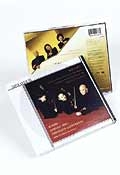SACD's Overture Page 2
You won't find the lyrics on your TV screen because, although SACD is capable of carrying video content, none of the discs reviewed here includes any. Not that visuals would appreciably help two entries from the audiophile label dmp, the Vivino Brothers' Blues Band (Music , Recording
) and the Bob Mintzer Big Band's Homage to Count Basie (Music
, Recording
). Each is just a four-channel mix - which isn't necessarily a bad thing (the excellent Tubular Bells is a four-channel disc, after all). But these are unremarkable mixes; in fact, they're textbook examples of how reserving the surround channels for just ambience will sometimes not do. As Robert Ripps notes below, dmp does much better with its choral entry, Sacred Feast. But here, it seems to be going through the multichannel motions.
Finally, with their Supersonic/BMG import Don't Give Me Names (Music , Recording
), I give you the Guano Apes - and you can have 'em. How these pedestrian German alt-rockers got the green light to make this heavy-breathing six-channel SACD is a mystery. The disc has been rolling around multichannel demo rooms like a marble stuck in a ship's overhead. May we all have smoother sailing with James Taylor and other surround SACDs yet to come.
-Ken Richardson
 The launch of classical music on multichannel SACD is impressive for its wide range of musical styles, from 16th-century English sacred choral music to 21st-century percussion ensemble. It's also worth noting that the acoustic environments captured here (with varying degrees of success) include the concert hall, the church, and the battlefield.
The launch of classical music on multichannel SACD is impressive for its wide range of musical styles, from 16th-century English sacred choral music to 21st-century percussion ensemble. It's also worth noting that the acoustic environments captured here (with varying degrees of success) include the concert hall, the church, and the battlefield.
Somewhat surprisingly, given the parent company's involvement in the development of SACD, Sony Classical's first multichannel entry is not one that is likely to draw much attention to the format. It's a perfectly decent recording of two works by Mozart (Performance , Recording
). The Sinfonia Concertante in E-flat has fine playing by violinist Midori, violist Nobuko Imai, and the NDR Symphony Orchestra of Hamburg conducted by Christoph Eschenbach. He doubles at the keyboard for the second work, the Concerto in D for Violin and Piano. While much is made in the program notes of the higher-than-usual tuning of the viola in this recording, the result is still a rather traditional-sounding and, by today's standards, somewhat heavy-handed approach to Mozart. The six-channel surround mix creates a natural concert-hall ambience - orchestra across the front, the soloists split front left and right, and the surround channels used sparingly - but in the concerto, the piano is somewhat muddy and overly resonant.
- Log in or register to post comments




















































